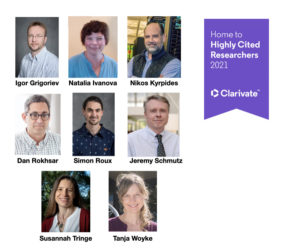 Congratulations to the 2021 Highly Cited Researchers at the JGI! They are among those recognized by Clarivate Analytics for demonstrating “significant influence in their chosen field or fields through the publication of multiple highly cited papers during the last decade.”
Congratulations to the 2021 Highly Cited Researchers at the JGI! They are among those recognized by Clarivate Analytics for demonstrating “significant influence in their chosen field or fields through the publication of multiple highly cited papers during the last decade.”
Approximately 6,600 researchers working in 21 fields appear on the list, and those from the JGI whose publications rank in the top 1% by citations for field and publication year are:
- Igor Grigoriev
- Natalia Ivanova
- Nikos Kyrpides
- Dan Rokhsar
- Simon Roux
- Jeremy Schmutz
- Susannah Tringe
- Tanja Woyke
Below are a few projects each of these researchers were involved in, reported on over the last year:
- Jeremy Schmutz was part of a long-term multi-institutional research team that combined field data with a reference switchgrass genome to associate climate adaptations with switchgrass biology. The information could be useful toward the DOE’s interest in harnessing the crop toward producing sustainable alternative fuels.
- Igor Grigoriev, Simon Roux, Susannah Tringe, and Tanja Woyke were among JGI staff who mentored students this past year, through programs including the JGI-UC Merced Genomics Internship Program and the DOE Office of Science Graduate Student Research (SCGSR) Program. (Watch SCGSR fellows Nick Reichart and Ian Rambo talk about their experiences at the JGI.)
- Igor Grigoriev hosted two JGI Engagement Webinars promoting the JGI fungal data portal MycoCosm and the algal portal PhycoCosm. Additionally, working with Michelle O’Malley’s team at the University of California, Santa Barbara, he and his colleagues found that anaerobic fungi from herbivore poop might be a new source of novel compounds to help bolster the bioeconomy.
- Natalia Ivanova was part of a team that hosted a series of webinars featuring aspects of the Integrated Microbial Genomes & Microbiomes (IMG/M)
- Nikos Kyrpides was part of an international research consortium that collected and analyzed microbial samples from public transit stations across 60 global cities. He and his colleagues used an extensive JGI database to investigate viruses detected in the samples.
- Simon Roux co-organized the Viral EcoGenomics & Applications (VEGA) Symposium series. The online seminars foster discussion on how to best capture and characterize uncultivated viruses, understand the role of viruses in natural ecosystems, and functionally explore viral genetic diversity toward innovative biotechnological and industrial applications. Videos from symposium talks are available here.
- Tanja Woyke appeared in a JGI Engagement Webinar on How to Successfully Apply for a CSP Proposal. She also co-organized the NeLLi 2021 Symposium: From New Lineages of Life to New Functions. The seminars focus on experimental innovations, computational advances, and other technological developments that will enable researchers to move from identification of microbial novelty to assigning metabolic and functional capabilities. Videos from symposium talks are available here.